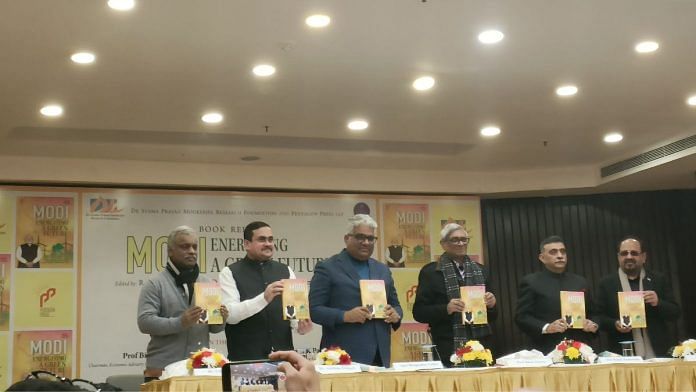New Delhi: Less than a month after COP-28 concluded and reported 2023 as the warmest year on record, Union ministers, civil servants and policymakers gathered at Delhi’s India International Centre to discuss India’s green future. The occasion, the launch of a collection of essays, Modi: Energising a Green Future published by Pentagon Press, was a celebratory pat on the back.
India’s renewable energy capacity, its air pollution problem, or even its emissions reduction target wasn’t the focus. Instead, all the six speakers, from Bhupender Yadav, the environment, forests and climate change minister who wrote two essays, to Bibek Debroy, chairman of the Economic Advisory Council to the PM and one of the book’s editors, spoke about “PM Modi’s vision”. Everyone lauded India’s contribution to the global climate change conversation.
“We are from a culture that has a deep ecological sense,” said Yadav, expanding on how Indic philosophy differs from the Western model of anthropocentrism. It was this ecological ethos that helped India establish a model of growth that does not destroy the environment.
The other editors of the book—released by the Syama Prasad Mookerjee Research Foundation (SPRM)—including former IPS officer R K Pachnanda, SPRM chairman Anirban Ganguly, and Uttam Kumar Sinha, senior fellow at the Manohar Parrikar Institute for Defence Studies and Analyses, took turns lauding the contributing authors, and the different aspects of climate policy in India. Other contributors included Haryana Chief Minister Manohar Lal Khattar and former IPS officer Hanis Qureshi.
“The overarching theme of the book was India’s climate ambition,” announced Sinha who then went on to talk about Modi’s contribution to India’s climate change space. It started with the Panchamrit, the five elements of India’s climate action that the PM had announced at the Glasgow UN Conference in 2021, which none of the panellists shied away from bringing up.
PM Modi’s vision
Uttam Sinha, also an editor of the book, carefully explained India’s position on the energy and climate space under the Bharatiya Janata Party (BJP)’s aegis in the past decade. He especially emphasised the importance of energy for India’s growth, and how the country was only going to need more energy, not less.
“This is where our PM’s action in promoting smart grids, renewable energy storage solutions, and electric vehicles comes into play,” he said.
The panellists did not delve deeper into many aspects of government policies and initiatives in the climate space, such as the Pradhan Mantri Kisan Urja Suraksha Evam Utthaan Mahabhiyan (PM-KUSUM) scheme for ensuring energy security for farmers. Further, the discussion didn’t quite explore the Unnat Jyoti by Affordable LED for All (UJALA) scheme, which encourages the usage of LED bulbs over incandescent ones.
Instead, panellists focused on Panchamrit and Mission LiFE — Lifestyle for Environment — a ‘collective action’ movement launched by Modi in October 2022. Hailing Mission LiFE, Ganguly said that it showed India and Indians as people who are “pro-planet”. He congratulated Modi for prompting ‘jan bhagidari’ (peoples’ participation) in a task as important as climate change action. Ganguly also called Yadav “the principal lieutenant of PM Modi’s environmental vision” while introducing him at the event.
The discussion found one locus point to come back to – Prime Minister Narendra Modi.
Also read:
A philosophy of environment conservation
Apart from promoting public participation in climate action through Mission LiFE, “India played a huge role in giving the world, for the first time perhaps, an environment conservation philosophy — Sarve Bhavantu Sukhinah (the whole world should be happy),” said Anirban Ganguly.
Modi first used this phrase at COP26 in 2021, where he also highlighted the need for “mindful and deliberate utilisation” of resources.
The focus then shifted to Yadav, who pointed out the historic inequalities in global development. Developed nations that used up crucial energy resources to progress are now preventing other nations from doing so. “India might be home to 17 per cent of the world’s population but has only contributed to 5 per cent of its emissions,” he said. The European Union and the US, which house just about 10 per cent of the world’s population, have contributed almost 50 per cent to these emissions, he added.
Also read:
‘Energising a Green Future’
Bibek Debroy took the dais to thank his fellow editors for making the book a success. The team – dubbed a ‘quadrilateral’ by Debroy – had previously published a book titled Modi 2.0: A Resolve to Secure India in 2021 that analysed the PM’s security policies.
Debroy then mentioned a social media post he once came across, about electric buses in New York and Guwahati. The post, which he admitted he had not fact-checked, said that while New York just had 15 electric buses, Guwahati had ordered a hundred. “Regardless of its accuracy, it does serve as a good metaphor for where the rest of the world stands with regards to India,” Debroy said triumphantly.
Toward the end of the hour-long discussion on India’s climate action achievements, Debroy solemnly said: “So far as the West is concerned, we will only see a whole lot of pontification about the climate but no actual work.”
(Edited by Zoya Bhatti)



